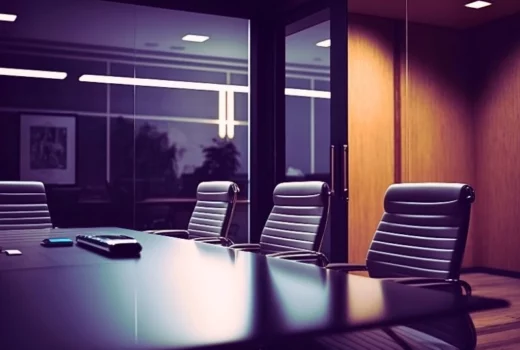
Schiff Hardin laid off seven current associates and retracted offers for four incoming associates yesterday, reports the ABA Journal. This comes after the widely publicized mass exodus of 22 partners in January, which included Schiff’s former managing partner.

Schiff isn’t the only big law firm that’s conducted massive layoffs this year. Reed Smith and Baker Donelson have also cut large numbers of attorneys and support staff in the recent months. In January, Reed Smith, the 19th highest-grossing law firm in the U.S. last year, laid off 45 attorneys and an unspecified number of staff, announced the Wall Street Journal.
Schiff Hardin managing partner Marci Eisenstein said in her statement that, despite the layoffs, the firm is “coming off a record year,” and are anticipating “another strong year in 2016,” (as reported by Above the Law).
Baker and McKenzie retains its title as the best-known law firm in the world, according recent rankings by UK-based research firm Acritas. However, although the “sun never sets on Baker & McKenzie’s empire,” reports The American Lawyer, “challengers continue to make progress against established, old-line firms in the minds of senior counsel at big corporations.”

Chief executive of Acritas, Lisa Hart Shepherd, observes that they are “continuing to see a decline, in the brand sense, of premium-priced brands,” but notes that global brand awareness is not easy to build in today’s increasingly fragmented market, where the average client works with 12 firms (as quoted in The American Lawyer).
If possible, however, corporate clients tend to favor sticking with their current domestic firms for any international work, said Shepherd. She adds that “once attention is won,” firms can keep such clients through “the promise of a great client experience and, for much of the work, good value” (as quoted in The American Lawyer).
Mary Young, a consultant at the Zeughauser Group, is quoted by The American Lawyer as advising any law firm trying to enter new markets to consider “what you can offer that others can’t, or what relationships you can leverage that others cannot.”
The Acritas surveys also found that many companies coveted more business-savvy firms–one client explaining that it gives the firm a competitive edge by being able to have a better understanding of potential risks and gains.
Read the full article at The American Lawyer.
Managing partner of Akerman’s Chicago office, Scott Meyers, sat down with Crain’s to discuss the firm’s growth strategy.

Akerman, a mid-sized, full-service firm based out of Miami, opened their Chicago office two years ago with eight lawyers, which has since grown a team of 45 attorneys.
Meyers tells Crain’s that he “never imagined [they] would be able to grow as quickly as [they] have,” but says that they won’t put a goal date on their plan of doubling in size. He explains that they are “optimistic enough” that they will “find enough wedge into the market” (as quoted in Crain’s).
Meyers points out that Akerman has managed to accomplish the same goal in New York, where their office has grown to nearly one hundred attorneys. “As I always tell my litigators,” he adds, “don’t tell people when you can show people” (as quoted in Crain’s).
The “vast majority” of lawyers and staff from Houston-based IP boutique Novack Druce Connolly Bove & Quigg will be absorbed into the fast-growing Polsinelli, according to recent reports by The American Lawyer.

Polsinelli chairman and CEO Russell Welsh told The American Lawyer that acquisition by Polsinelli, which currently has just over 700 attorneys, will enhance their already “robust IP practice,” especially in the burgeoning area of post-grant patent reviews (as quoted in The American Lawyer).
Novak Druce, which had 140 attorneys in 2012, has been losing “a stream of partners to competitors,” The American Lawyer reports, including Drinker Biddle, Reed Smith, and Dykema Gossett. This mirrors the ongoing trend for intellectual property boutiques in the recent years, many of which have been struggling and have since been absorbed into or have had partners taken by mid-sized, full-service firms like Polsinelli.
Ranked the fast-growing firm for the seventh year in the row, Polsinelli has experienced continued success in their expansion efforts, with revenue rising 11.4 percent in 2015 (The American Lawyer). Their now-proven strategy is to concentrate growth in low overhead markets in order to compete for health care work and other “price-sensitive assignments.” Todd Dickinson of Novack Druce’s executive committee agrees with their method, telling The American Lawyer that Polsinelli utilizes a “Midwest sensibility about rates that’s client friendly.”
Finding a foothold in the Chicago market isn’t as easy for the elite ‘big law’ firms as they might like to believe, reports Claire Bushey of Crain’s Chicago.

The article looks at three national firms that had big aspirations for growth upon their respective moves to Chicago: Paul Hastings, Ropes & Gray, and Morgan Lewis & Bockius. New York-based Paul Hastings, for example, opened its Chicago doors in 2006, initially recruiting top partner talent and reporting goals of a 100+ lawyer office. Ten years later, the office boasts of only 42 attorneys. Former managing partner of the office, Rick Chesley, says that its the tough Chicago competition that forces firms to really consider their client base: “If you haven’t thought about who your clients are, who you’re going to compete with…you’re going to fail,” he said (as quoted in Crain’s).
Similarly, Boston-based Ropes & Gray opened eight years ago with predictions of a 100-lawyer headcount within two years. The Chicago office has only 64 attorneys to date–a stark contrast to their London office, which went from 2 attorneys at their 2010 opening to 129 today.
Anthony Nasharr, Managing Partner of the Chicago office of Polsinelli, believes that firms looking to expand into Chicago need to be “chasing work characteristic to the city, like agribusiness or financial services” (as quoted in Crain’s). Polsinelli, a firm headquartered in Kansas City, has proven that they have the right approach for Chicago growth, successfully growing their six-attorney starter office to almost 100 in just eight years. Nasharr also notes that a new Chicago office requires strong support from their headquarters to help the office thrive–like supplying the funds to bring on quality lateral partners. Much Shelist Managing Partner Mitchell Roth agrees that the need for good talent is critical to success in any major market, but argues that acquiring that talent can prove difficult: “To open a five-person office and expand to 100 in one or two years, when everyone’s trying to buy the exact same talent? It’s next to impossible,” he says (as quoted in Crain’s).
Despite the difficulties, six out-of-town firms merged with Chicago firms last year–more than in any other city, Crain’s reports. However, former Kirkland & Ellis partner Steven Harper warns the newcomers not to be fooled into thinking their high-profile reputations will be their be-all, end-all for attracting clients: “These firms believe that…clients will flock to the brand. Well, maybe not. Probably not,” he cautions (as quoted in Crain’s).
Seeming to defy the laws of supply and demand, hourly billing rates at national corporate law firms have increased 3 to 4 percent per year since the recession, according to Citi Private Bank’s Law Firm Group (The Wall Street Journal). In fact, they report, these rates have continued to rise in spite of weak demand and low inflation.

A recent study of bankruptcy cases revealed that “senior partners routinely charge between $1,200 and $1,300 an hour, with top rates at several large law firms exceeding $1,400” (The Wall Street Journal). Legal consultant Bruce MacEwen observes that “you have a very few people at the very top where price is almost no object,” allowing for the best-of-the-best lawyers to charge an astounding $1,800-plus hourly rate (as quoted in The Wall Street Journal).
While demand for legal services has only risen 0.5% in the past year, revenue has risen by 4%, according to Wells Fargo Private Bank’s Legal Speciality Group. Heightened rates help to increase this revenue, and are consistently raised to soften the blow of client-demanded discounts, an increasingly common practice. By implementing an annual rate increase, says an Altman Weil legal consultant, law firms are able to offset clients’ requests for discounts (The Wall Street Journal).
John Altorelli, finance lawyer at DLA Piper, laments that “we just raise them every year,” referring to the hourly rate system as “anachronistic” (as quoted in The Wall Street Journal). However, many firms contend that raising rates are a way to “guarantee salaries or ensure a partner’s pay doesn’t fall, even in the down years,” allowing them to attract and keep the top talent (The Wall Street Journal).
Still, argues legal consultant Bruce MacEwen,”if clients are pushing back on rates, the answer isn’t to raise them, and then ask for a discount…the answer is to provide a better total value” (WSJ).
Read more and see the top law firm billers at the Wall Street Journal.
The frenzy of mergers between IP boutiques and national full-service firms shows no signs of abatement, The American Lawyer reports. Since April, at least eight IP firms have been acquired by Am Law 200 firms, driven largely in part by the recent changes in patent law, according to the article.

The America Invents Act, passed in 2011, allows the Patent Trial and Appeal Board to review patent challenges, creating a quicker and less costly alternative to litigating in federal district courts.
However, patent litigation “remains hot,” the article argues, citing the results of a Lex Machina study, which found that patent litigation in the U.S. increased by 15 percent last year. The struggle for boutique patent firms, according to shareholder Thomas Anderson of Gifford Krass, a firm that merged with Dinsmore this past fall, is acquiring and keeping the larger clients. Anderson says that it “becomes hard for a firm of our size to attract large-scale patent litigation [because] Fortune 50 companies want large firms with lots of resources” (as quoted in The American Lawyer).
Larger, full-service firms view the bolting on of IP boutiques as a quick and easy way to build up their patent practice, an area which is “incredibly important” to clients, says Lewis Rose, managing partner of Kelley Drye.
With boutique IP firms across the country continuing to battle to maintain revenue and retain partners, it looks like this merger rush won’t be slowing down anytime soon.
Partner moves were at their highest count yet in 2015, the “strongest year since 2009 for lateral partner moves at big law firms,” according to The American Lawyer. ALM’s Legal Intelligence branch (ALI) tracked lateral partner moves at Am Law 200 firms and found an astounding 43.5 percent increase since 2010, as well as a 5.6 percent increase from 2014.

‘Lateral lift-outs,’ the co-departure of a group of attorneys from a firm, have also been increasingly popular. Gretta Rusanow of Citi Bank’s Law Firm Group notes that a firm “may look to bring on a group of partners, believing that it increases the likelihood of the laterals’ clients moving to a new firm,” (as quoted in The American Lawyer).
Nearly thirty percent (28.1) of the lateral partner hires were litigators, followed by corporate, banking and finance, and intellectual property attorneys (The American Lawyer). Chicago, along with New York, D.C., Boston, and Los Angeles showed active lateral partner activity, according to the report.
Intellectual property boutique Brinks, Gilson, & Leone lost four litigation partners to Midwest-based Barnes & Thornburg last week, according to The American Lawyer. This follows the recent trend for IP boutiques, many of which have either been absorbed by larger firms or have also had an unusually large number of partners depart.

John Gabrielides, one of the four partners that moved to Barnes, explained that they felt “limited in the services we could offer to our clients” at Brinks Gilson, and that joining a full-service firm “gives us a lot more flexibility and latitude” (as reported by The American Lawyer).